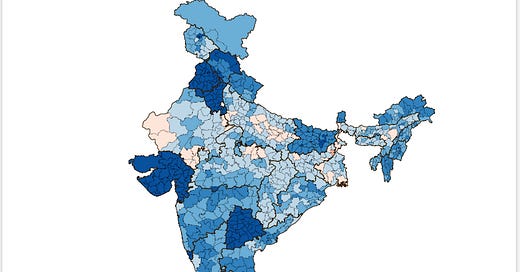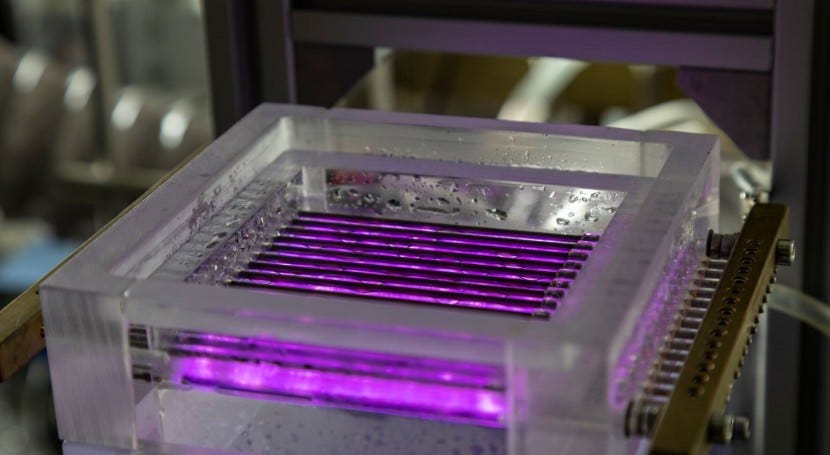#166 - Mobile Water Solutions, Saltwater batteries, & News from the World of Water
Water Water Everywhere...
Dear Readers,
Spring is finally in the air but as you shrug off the layers and get some sun, remember to hydrate both physically and mentally with this newsletter.
Remember to like this weekly dispatch, or share it with friends so they too can subscribe!
Weekly News Roundup
People think of water problems as a developing world issue, but right here in the United States, 46 Million Americans either have no running water or water that may be unsafe to drink. Don’t take our word for it, read this report by the US Water Alliance & Dig Deep.
While Dig Deep is working to get water access to the Navajo Nation, they are doing their part too. For more than 20 years, the Navajo Nation has fought for access to water from the lower Colorado River, which flows directly alongside the reservation's northwestern border. We’ve written about the contentious environment around the Colorado river water, but when big agricultural and populous states like Arizona, California and Nevada rely on the Colorado River water reaching them, sharing it with another party is going to be issue irrespective of who believes they have the rights.
Further afield in Nigeria, the cost of packets of clean drinking water has gone up so much (from N50 for 20 sachets, a few years ago, to N50 for 1 sachet today), that Nigerians are going back to drinking whatever water they can get from local boreholes, and wells.
New analysis from the UN children’s agency, UNICEF, shows that some 190 million children in 10 African countries are at the highest risk from a convergence of three water-related threats – inadequate water, sanitation, and hygiene (WASH); related diseases; and climate hazards.
I know the numbers tend to make us glaze over at the UN showing big problems, but perhaps the takeaway here is that these problems can be solved and have been solved in India and other parts of the developing world.
In Better News
Australia's national science agency, CSIRO, has setup a weather service for water quality – they say it will support better water quality management and can be used to monitor water quality for drinking, sanitation, aquaculture, environmental assessment and a wide range of other applications to help meet the United Nations' Sustainable Development Goals.
Back stateside, California has awarded the city of Paso Robles a $9.7M grant for the construction of the city’s Recycled Water Distribution System project. As more cities in the drought-ridden states move into water recycling, things can only get better.
Weekly Innovations Roundup
Plasma to clean pharmaceutical residue in water
We’ve talked in the past about how pharmaceuticals pass through human beings and animals alike, get washed out with the wastewater and end up in public bodies of water. These drug residues are amongst the most persistent contaminants that make them very hard to remove. Unsurprisingly water contamination with pharmaceutical residues is particularly high at/ around hospitals.
Enter the boffins at Leibniz Institute for Plasma Science and Technology (INP). They have built mobile water treatment solutions that combine the traditional wastewater treatment methods with new technologies such as ultrasound, pulsed electric fields and plasma technology. While they’re intentionally light on specifics (one imagines due to pending patents/ copyright) you can find out more on their website by searching for PlasRes.
Solar Nanogrid with water purification built-in
A US based startup has created a mobile nano-grid solution to aid remote communities or communities in disaster situations. This trailer sized solution, includes retractable solar panels to power the system which can provide anywhere between three to 20 kilowatts of energy - enough for 4-6 houses. It also has an onboard water filtration system that can be deployed to provide 132 gallons (500 liters) of drinking water every day.
Additionally this ‘nano-grid’ also uses solar energy to split water and store the hydrogen gas to serve as a reserve fuel when the onboard battery capacity dips below 35 percent, as well as a 5G mesh network so people displaced in a disaster can get online. Now for the kicker - A single unit of this versatile nano grid can cost between $100,000 to $375,000. Cue the bank run?
Saltwater flow battery for desalination
A US-based company has developed a scalable redox flow battery with two separate tanks of electrolytes, one of which is saltwater. This is know as a saltwater flow battery cycle, which involves the movement of ions between two electrodes to store or discharge electricity without a membrane. In this case, the process is used to remove salt from brine or seawater. The system can use a renewable energy source, such as solar power or a large wind turbine, to charge the battery, making it both environmentally friendly and cost-effective.
This is very energy efficient since this happens simultaneously to the charging of the battery, so it is in effect a free side benefit of battery charging. Given that its developed by a marine application company, one assumes they see this as an add-on solution to give both ancillary power and clean water as part of a ship’s onboard power storage system. They go on to say that new desalination system is currently being developed in a lab setting and will be trialed in a real-world environment for both stationary and marine vessel applications.
That’s it for this week,
‘Til next week,
Peace!






